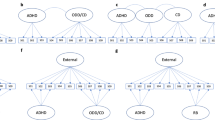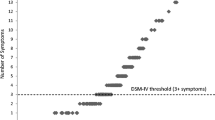Abstract
Emerging research has identified sub-dimensions of oppositional defiant disorder – irritability and defiance - that differentially predict internalizing and externalizing symptoms in preschoolers, children, and adolescents. Using a theoretical approach and confirmatory factor analyses to distinguish between irritability and defiance, we investigate the associations among these dimensions and internalizing (anxiety and depression) and externalizing problems (conduct problems) within and across time in a community-based sample of 662 youth (342 females) spanning ages 12 to 18 years old at baseline. On average, irritability was stable across assessment points and defiance declined. Within time, associations of irritability with internalizing were consistently stronger than associations of irritability with conduct problems. Defiance was similarly associated within time with both internalizing and conduct problems in mid-adolescence, but was more highly related to internalizing than to conduct problems by early adulthood (ages 18 to 25). Over time, increasing irritability was related to changes in both internalizing and conduct problems; whereas increases in defiance predicted increases in conduct problems more strongly than internalizing symptoms. Increases in both internalizing and conduct problems were also associated with subsequent increases in both irritability and defiance. Sex differences in these associations were not significant.


Similar content being viewed by others
References
Aebi, M. M., Müller, U. C., Asherson, P. P., Banaschewski, T. T., Buitelaar, J. J., Ebstein, R. R., & Steinhausen, H. C. (2010). Predictability of oppositional defiant disorder and symptom dimensions in children and adolescents with ADHD combined type. Psychological Medicine: A Journal of Research In Psychiatry and The Allied Sciences, 40, 2089–2100. doi:10.1017/S0033291710000590.
Beggs, D. J., Langley, D. J., & Williams, S. M. (1999). Validity of self reported crashes and injuries in a longitudinal study of young adults. Injury Prevention, 5, 142–144. doi:10.1136/ip.5.2.142.
Bollen, K. A., & Curran, P. J. (2006). Latent curve models: A structural equation approach. Wiley Series on probability and mathematical statistics. New Jersey: Wiley.
Bontempo, D.E., & Hofer, S.M. (2007). Assessing factorial invariance in cross-sectional and longitudinal studies. In A.D. Ong & M. van Dulmen (Eds.), Handbook of methods in positive psychology (pp. 153–175). Oxford University Press.
Boyle, M. H., Cunningham, C. E., Georgiades, K., Cullen, J., Racine, Y., & Pettingill, P. (2009). The Brief Child and Family Phone Interview (BCFPI): 2. Usefulness in screening for child and adolescent psychopathology. Journal of Child Psychology and Psychiatry, 50, 424–431. doi:10.1111/j.1469-7610.2008.01971.x.
Bradford, S., & Rickwood, D. (2012). Psychosocial assessments for young people: a systematic review examining acceptability, disclosure and engagement, and predictive utility. Adolescent Health, Medicine and Therapeutics, 3, 111–125. doi:10.2147/AHMT.S38442.
Brown, T. A. (2006). Confirmatory factor analysis for applied research. New York: Guilford Press.
Burke, J. D. (2012). An affective dimension within oppositional defiant disorder symptoms among boys: personality and psychopathology outcomes into early adulthood. Journal of Child Psychology and Psychiatry, 53, 1176–1183. doi:10.1111/j.1469-7610.2012.02598.x.
Burke, J., & Loeber, R. (2010). Oppositional defiant disorder and the explanation of the comorbidity between behavioral disorders and depression. Clinical Psychology: Science and Practice, 17, 319–326. doi:10.1111/j.1468-2850.2010.01223.x.
Burke, J. D., Hipwell, A. E., & Loeber, R. (2010). Dimensions of oppositional defiant disorder as predictors of depression and conduct disorder in preadolescent girls. Journal of the American Academy of Child & Adolescent Psychiatry, 49, 484–492. doi:10.1097/00004583-201005000-00009.
Chen, C. E. (2012). Behavioral disorders in girls: A closer look at the epidemiology and development of oppositional defiant disorder and conduct disorder. In P. K. Lundberg-Love, K. L. Nadal, & M. A. Paludi (Eds.), Women and mental disorders (Vols 1–4) (pp. 189–207). Santa Barbara: Praeger/ABC-CLIO.
Copeland, W., Shanahan, L., Costello, E., & Angold, A. (2009). Childhood and adolescent psychiatric disorders as predictors of young adult disorders. Archives of General Psychiatry, 66, 764–772. doi:10.1001/archgenpsychiatry.2009.85.
Costello, E., Copeland, W., & Angold, A. (2011). Trends in psychopathology across the adolescent years: what changes when children become adolescents, and when adolescents become adults? Journal of Child Psychology and Psychiatry, 52, 1015–1025. doi:10.1111/j.1469-7610.2011.02446.x.
Cunningham, C. E., Boyle, M. H., Hong, S., Pettingill, P., & Bohaychuk, D. (2009). The Brief Child and Family Phone Interview (BCFPI): 1. Rationale, development, and description of a computerized children’s mental health intake and outcome assessment tool. Journal of Child Psychology and Psychiatry, 50, 416–423. doi:10.1111/j.1469-7610.2008.01970.x.
De Ancos, E., & Ascaso, L. (2011). Sex differences in oppositional defiant disorder. Psicothema, 23(4), 666–671.
Drabick, D. G., & Gadow, K. D. (2012). Deconstructing oppositional defiant disorder: clinic-based evidence for an anger/irritability phenotype. Journal of the American Academy Of Child & Adolescent Psychiatry, 51, 384–393. doi:10.1016/j.jaac.2012.01.010.
Drabick, D. A. G., Ollendick, T. H., & Bubier, J. L. (2010). Co-occurrence of ODD and anxiety: shared risk processes and evidence for a dual-pathway model. Clinical Psychology: Science and Practice, 17, 307–318. doi:10.1111/j.1468-2850.2010.01222.x.
Duncan, T. E., Duncan, S. C., & Strycker, L. A. (2006). An introduction to latent variable growth curve modeling: Concepts, issues, and applications (2nd ed.). New York: Psychology Press.
Ezpeleta, L., Granero, R., de la Osa, N., Penelo, E., & Domènech, J. M. (2012). Dimensions of oppositional defiant disorder in 3‐year‐old preschoolers. Journal of Child Psychology and Psychiatry, 53, 1128–1138. doi:10.1111/j.1469-7610.2012.02545.x.
Fabrigar, L. R., Wegener, D. T., MacCallum, R. C., & Strahan, E. J. (1999). Evaluating the use of exploratory factor analysis in psychological research. Psychological Methods, 4, 272–299. doi:10.1037/1082-989X.4.3.272.
Frick, P.J., & Nigg, J.T. (2012). Current issues in the diagnosis of attention deficit hyperactivity disorder, oppositional defiant disorder, and conduct disorder. Annual Review Of Clinical Psychology, 877–107. doi:10.1146/annurev-clinpsy-032511-143150.
Gadermann, A.M., Guhn, M. & Zumbo, B. (2012). Estimating ordinal reliability for Likert-type and ordinal item response data: A conceptual, empirical, and practical guide. Practical Assessment, Research & Evaluation, 17. Available online: http://pareonline.net/getvn.asp?v=17&n=3.
Graber, J. A., & Sontag, L. M. (2009). Internalizing problems during adolescence. In R. M. Lerner & L. Steinberg (Eds.), Handbook of adolescent psychology, Vol 1: Individual bases of adolescent development (3rd ed., pp. 642–682). Hoboken: Wiley.
Hames, J., Hagan, C., & Joiner, T. (2013). Interpersonal processes in depression. Annual Review of Clinical Psychology, 9, 355–377. doi:10.1146/annurev-clinpsy-050212-185553.
Hipwell, A. E., Stepp, S., Feng, X., Burke, J., Battista, D. R., Loeber, R., & Keenan, K. (2011). Impact of oppositional defiant disorder dimensions on the temporal ordering of conduct problems and depression across childhood and adolescence in girls. Journal of Child Psychology and Psychiatry, 52, 1099–1108. doi:10.1111/j.1469-7610.2011.02448.x.
Keenan, K. (2012). Mind the gap: assessing impairment among children affected by proposed revisions to the diagnostic criteria for oppositional defiant disorder. Journal of Abnormal Psychology, 121, 352–359. doi:10.1037/a0024340.
Kolko, D. J., & Pardini, D. A. (2010). ODD dimensions, ADHD, and callous–unemotional traits as predictors of treatment response in children with disruptive behavior disorders. Journal of Abnormal Psychology, 119, 713–725. doi:10.1037/a0020910.
Krieger, F., Polanczyk, G., Goodman, R., Rohde, L., Graeff-Martins, A., Salum, G., & Stringaris, A. (2013). Dimensions of oppositionality in a Brazilian community sample: testing the DSM-5 proposal and etiological links. Journal of the American Academy Of Child & Adolescent Psychiatry, 52, 389–400. doi:10.1016/j.jaac.2013.01.004.
Leadbeater, B., Kuperminc, G., Blatt, S., & Hertzog, C. (1999). A multivariate model of gender differences in adolescents’ internalizing and externalizing problems. Developmental Psychology, 35, 1268–1282. doi:10.1037/0012-1649.35.5.1268.
Leadbeater, B. J., Thompson, K., & Gruppuso, V. (2012). Co-occurring trajectories of symptoms of anxiety, depression, and oppositional defiance from adolescence to young adulthood. Journal of Clinical Child and Adolescent Psychology, 41, 719–730. doi:10.1080/15374416.2012.694608.
Little, T. (2013). Longitudinal structural equation modeling. New York: Guildford Press.
MacPherson, H. A., Cheavens, J. S., & Fristad, M. A. (2013). Dialectical behavior therapy for adolescents: theory, treatment adaptations, and empirical outcomes. Clinical Child and Family Psychology Review, 16, 59–80. doi:10.1007/s10567-012-0126-7.
Moretti, M. M., & Obsuth, I. (2009). Effectiveness of an attachment-focused manualized intervention for parents of teens at risk for aggressive behaviour: the connect program. Journal of Adolescence, 32, 1347–1357. doi:10.1016/j.adolescence.2009.07.013.
Munkvold, L., Lundervold, A., & Manger, T. (2011). Oppositional defiant disorder—Gender differences in co-occurring symptoms of mental health problems in a general population of children. Journal of Abnormal Child Psychology, 39, 577–587. doi:10.1007/s10802-011-9486-6.
Muthén, L.K., & Muthén, B.O. (1998–2012). Mplus User’s Guide. Seventh Edition. Los Angeles, CA: Muthén & Muthén. Retrieved from http://www.statmodel.com.
Rowe, R., Costello, E., Angold, A., Copeland, W. E., & Maughan, B. (2010). Developmental pathways in oppositional defiant disorder and conduct disorder. Journal of Abnormal Psychology, 119, 726–738. doi:10.1037/a0020798.
Rudolph, K. D., & Clark, A. G. (2001). Conceptions of relationships in children with depressive and aggressive symptoms: social-cognitive distortion or reality? Journal of Abnormal Child Psychology, 29, 41–56. doi:10.1023/A:1005299429060.
Shankman, S., Lewinsohn, P., Klein, D., Small, J., Seeley, J., & Altman, S. (2009). Subthreshold conditions as precursors for full syndrome disorders: a 15-year longitudinal study of multiple diagnostic classes. The Journal of Child Psychology and Psychiatry, 50, 1485–1494. doi:10.1111/j.1469-7610.2009.02117.x.
Stringaris, A., & Goodman, R. (2009). Longitudinal outcome of youth oppositionality: irritable, headstrong, and hurtful behaviors have distinctive predictions. Journal of the American Academy of Child & Adolescent Psychiatry, 48, 404–412. doi:10.1097/CHI.0b013e3181984f30.
Stringaris, A., Cohen, P., Pine, D., & Leibenluft, E. (2009). Adult outcomes of youth irritability: A 20-year prospective community-based study. American Journal of Psychiatry, 166, 1048–1054. doi: 10.1176/appi.ajp.2009.08121849.
Stringaris, A., Zavos, H., Leibenluft, E., Maughan, B., & Eley, T. C. (2012). Adolescent irritability: phenotypic associations and genetic links with depressed mood. The American Journal of Psychiatry, 169, 47–54. doi:10.1176/appi.ajp.2011.10101549.
Stringaris, A., Maughan, B., Copeland, W. S., Costello, E., & Angold, A. (2013). Irritable mood as a symptom of depression in youth: prevalence, developmental, and clinical correlates in the great smoky mountains study. Journal of the American Academy Of Child & Adolescent Psychiatry, 52, 831–840. doi:10.1016/j.jaac.2013.05.017.
Whelan, Y. M., Stringaris, A., Maughan, B., & Barker, E. D. (2013). Developmental continuity of oppositional defiant disorder subdimensions at ages 8, 10, and 13 years and their distinct psychiatric outcomes at age 16 years. Journal of the American Academy Of Child & Adolescent Psychiatry, 52, 961–969. doi:10.1016/j.jaac.2013.06.013.
Conflict of Interest
The authors declare that they have no conflict of interest.
Author information
Authors and Affiliations
Corresponding author
Rights and permissions
About this article
Cite this article
Leadbeater, B.J., Homel, J. Irritable and Defiant Sub-Dimensions of ODD: Their Stability and Prediction of Internalizing Symptoms and Conduct Problems from Adolescence to Young Adulthood. J Abnorm Child Psychol 43, 407–421 (2015). https://doi.org/10.1007/s10802-014-9908-3
Published:
Issue Date:
DOI: https://doi.org/10.1007/s10802-014-9908-3




